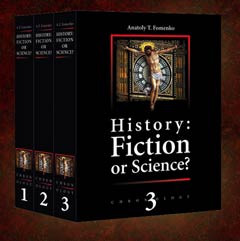
624 pages,
446 illustrations

Who's Who?
Jupiter
Sagittarius
Saturn
Scorpio
Venus
Leo
Mars
Gemini
Taurus
Perseus
Mercury
Libra
Sun
Virgo
Moon

|
view operas online! |
||
|
Moon
| |
Learn how and why Ancient Rome, Greece and Egypt were invented and crafted during Renaissance. Discover the Old Testament as a veiled rendition of events of Middle Ages written centuries after the New Testament. Perceive the Crusaders as contemporaries of The Crucifixion punishing the tormentors of the Messiah. What if Jesus Christ was born in 1053 and crucified in 1086 AD?
|
|
|
The Moon has fascinated mankind throughout the ages. By simply viewing with the naked eye, one can discern two major types of terrain: relatively bright highlands and darker plains. By the middle of the 17th century, Galileo and other early astronomers made telescopic observations, noting an almost endless overlapping of craters. It has also been known for more than a century that the Moon is less dense than the Earth. Although a certain amount of information was ascertained about the Moon before the space age, this new era has revealed many secrets barely imaginable before that time. Current knowledge of the Moon is greater than for any other solar system object except Earth. This lends to a greater understanding of geologic processes and further appreciation of the complexity of terrestrial planets. |
|
| top
|
|